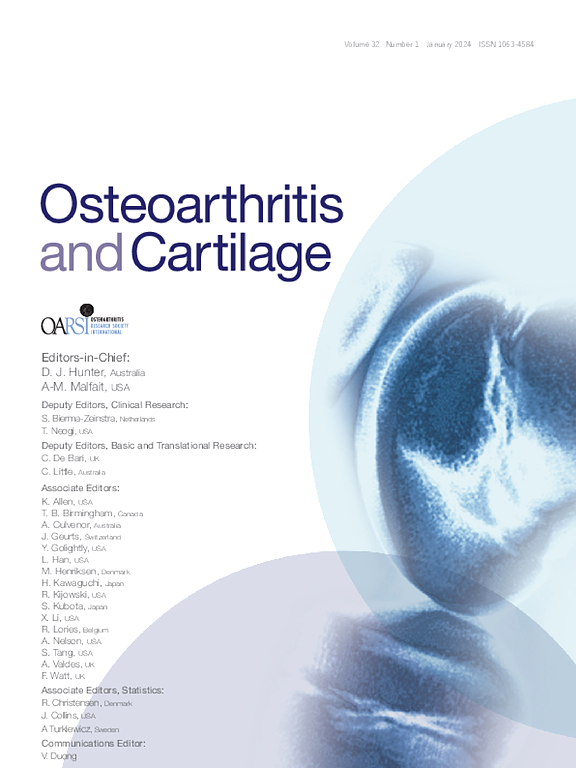关节内透明质酸对骨关节炎症状的疗效及相关因素的定量分析:随机试验的系统回顾和基于模型的荟萃分析。
IF 7.2
2区 医学
Q1 ORTHOPEDICS
引用次数: 0
摘要
目的透明质酸(HA)治疗骨关节炎(OA)的疗效文献仍有争议,适用亚群尚不清楚。我们的研究旨在定量评估透明质酸的功效,并确定从透明质酸中获益最多的潜在应答者。检索了从建库到2023年3月13日的METHODEmbase、MEDLINE (PubMed)和Cochrane图书馆对照试验中央注册库。采用药效学贝特曼功能模型定量评价透明质酸治疗与安慰剂的疗效特征,采用协变量模型确定显著影响疗效的因素。结果共纳入了来自168项研究的24101名有症状性或影像学表现的OA患者。药效学时效模型模拟分析显示,HA治疗效果在2个月左右达到稳定。最终的模型分析表明,与其他组相比,关节内注射HA联合皮质类固醇(西安大略省和麦克马斯特大学关节炎指数[WOMAC]疼痛效应大小[ES] = 4.4 [95% CI: 3.0至5.7])或富血小板血浆(WOMAC疼痛效应大小[ES] = 4.0 [95% CI: 2.7至5.3])取得了最佳疗效(meta分析对比:WOMAC疼痛效应大小= 1.9 [95% CI: 1.2至5.2])。亚组分析显示,较年轻(年龄< 65岁)、超重(BMI≥25)、基线症状较严重、Kellgren-Lawrence (KL)评分较低(≤2)的膝关节OA患者获益更多。结论定量模型显示,HA干预在统计学上比安慰剂更有效,其中HA+皮质类固醇(CS)或富血小板血浆(PRP)治疗效果最佳。年龄较小、体重较高、基线症状严重程度较高和KL等级较低的患者似乎从HA治疗中获益更多。数据和材料的可用性所有数据均可在正文或补充材料中获得。本文章由计算机程序翻译,如有差异,请以英文原文为准。
Quantitative analysis of the efficacy and associated factors of intra-articular hyaluronic acid with respect to osteoarthritis symptoms: A systematic review of randomized trials and model-based meta-analysis
Objective
To quantitatively evaluate hyaluronic acid (HA) efficacy for osteoarthritis (OA) and identify potential responders who would benefit most from HA.
Method
Embase, MEDLINE (PubMed), and the Cochrane Library Central Register of Controlled Trials were searched from inception to March 13, 2023. A pharmacodynamic Bateman function model was used to quantitatively evaluate the efficacy characteristics of HA treatments as well as placebo, while a covariate model was employed to identify factors that significantly affected efficacy.
Results
In total, 24 101 participants with symptomatic or radiographic OA from 168 studies with aggregate data were included. Simulation analysis from the pharmacodynamic time-effect model showed that HA treatment effects plateaued at approximately 2 months. The final model analysis indicated that intra-articular injection of HA combined with corticosteroids (CS) (the Western Ontario and McMaster Universities Osteoarthritis Index [WOMAC] pain effect size [ES] = 4.4 [95% confidence interval {CI}: 3.0 to 5.7]) or platelet-rich plasma (PRP) (WOMAC pain ES = 4.0 [95% CI: 2.7 to 5.3]) achieved the best efficacy compared with other groups (contrast between meta-analyses: WOMAC pain ES = 1.9 [95% CI: 1.2 to 5.2]). Subgroups analysis showed that younger (age < 65), overweight (body mass index ≥ 25) knee OA patients, with more severe baseline symptoms and a lower Kellgren-Lawrence (KL) grade (≤ 2), could benefit more.
Conclusion
The quantitative model suggested that HA interventions were statistically more effective than placebo, with participants receiving HA+ CS or PRP experiencing the best efficacy. Patients with lower age, higher weight, higher severity of baseline symptoms, and lower KL grade appeared to benefit more from HA treatment.
求助全文
通过发布文献求助,成功后即可免费获取论文全文。
去求助
来源期刊

Osteoarthritis and Cartilage
医学-风湿病学
CiteScore
11.70
自引率
7.10%
发文量
802
审稿时长
52 days
期刊介绍:
Osteoarthritis and Cartilage is the official journal of the Osteoarthritis Research Society International.
It is an international, multidisciplinary journal that disseminates information for the many kinds of specialists and practitioners concerned with osteoarthritis.
 求助内容:
求助内容: 应助结果提醒方式:
应助结果提醒方式:


